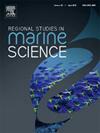黑海乌克兰水域的微塑料和鱼类浮游生物
IF 2.1
4区 环境科学与生态学
Q3 ECOLOGY
引用次数: 0
摘要
浮游生物和神经生物以微塑料为食并随后通过海洋食物网转移微塑料的能力已得到广泛研究。然而,目前还没有关于黑海西北部微塑料的研究。本研究评估了两个表层中微塑料和鱼类浮游生物的多样性和空间分布情况:0-5 厘米(neuston 表层;NL)和 5-20 厘米(hyponeuston 表层;HL)。取样工作于 2020 年 6 月至 2021 年 10 月在黑海西北部的沿海(CW)和开放(OW)水域进行。在所有研究地点都观察到了微塑料,微塑料由纤维(75%)和碎片(25%)组成。黑色和红色纤维是最多的纤维类型,碎片中以黑色颗粒为主。拉曼光谱鉴定出四种聚合物:聚乙烯、聚酯、聚氨酯和聚丙烯。海岸附近的微塑料浓度明显高于开放水域;化武中的平均微塑料浓度在北大西洋和北冰洋分别达到 136±74 (±SE)粒和 46±30 粒.m-3,而在大洋深处的北大西洋和北冰洋分别达到 18±3 粒.m-3 和 2±0.8 粒.m-3。在北大西洋,只有 31% 的地点发现了鱼类浮游生物,而在南大洋,只有 24% 的地点发现了鱼类浮游生物。总共记录到 6 种鱼类。数量最多的鱼种是欧洲鳀鱼,它是黑海的主要商业鱼种之一。在存在鱼类浮游生物的两个层中,微塑料与鱼类浮游生物的比例均为 0.34(或 1:2.87)。考虑到所有研究地点,微塑料与鱼类浮游生物的比例为 1.07(或 1:0.93)。由于鱼类浮游生物是 neuston 群落中的短暂组成部分,而微塑料却无处不在,我们可以认为,微塑料与鱼类浮游生物的密度相当,有利于它们之间的相互关系、负面影响以及在食物网中的迁移。本文章由计算机程序翻译,如有差异,请以英文原文为准。
Microplastic and ichthyoplankton in the Ukrainian waters of the Black Sea
The ability of planktonic and neustonic organisms to feed on microplastics and subsequently transfer it through the marine food web has been studied extensively. However, there are no studies on microplastic in the Northwestern Black Sea. The present study assesses the diversity and spatial distribution of microplastics and ichthyoplankton in two surface layers: 0–5 cm (neuston surface layer; NL) and 5–20 cm (hyponeuston layer; HL). The sampling was undertaken in June 2020 – October 2021 in the coastal (CW) and open (OW) waters of the Northwestern Black Sea. Microplastics was observed at all studied sites and was composed of fibres (75 %) and fragments (25 %). Black and red fibres were the most abundant type of fibre, and black particles dominated the fragments. Four types of polymers were identified by Raman spectroscopy: polyethylene, polyester, polyurethane, polypropylene. The concentration of microplastics near the coast significantly exceeded that of open waters; the average microplastics concentration in the CW reached 136±74 (±SE) and 46±30 particles.m-3 in the NL and HL, respectively, whereas it reached 18±3 and 2±0.8 particles.m-3 in the NL and HL of the OW, respectively. In the NL, ichthyoplankton was found only at 31 % of the sites, and at only 24 % of sites in the HL. In total, 6 species of fish were recorded. The most abundant species was the European anchovy, one of the main commercial species in the Black Sea. The ratio of microplastics to ichthyoplankton was 0.34 (or 1:2.87) for both layers, where ichthyoplankton was present. When considering all studied sites, the ratio of microplastics to ichthyoplankton was 1.07 (or 1:0.93). As ichthyoplankton is an ephemeral component of the neuston community, but microplastics is omnipresent, we may consider that comparable densities of microplastics:ichthyoplankton favour their interrelation, negative effect, and transport through the food web.
求助全文
通过发布文献求助,成功后即可免费获取论文全文。
去求助
来源期刊

Regional Studies in Marine Science
Agricultural and Biological Sciences-Ecology, Evolution, Behavior and Systematics
CiteScore
3.90
自引率
4.80%
发文量
336
审稿时长
69 days
期刊介绍:
REGIONAL STUDIES IN MARINE SCIENCE will publish scientifically sound papers on regional aspects of maritime and marine resources in estuaries, coastal zones, continental shelf, the seas and oceans.
 求助内容:
求助内容: 应助结果提醒方式:
应助结果提醒方式:


